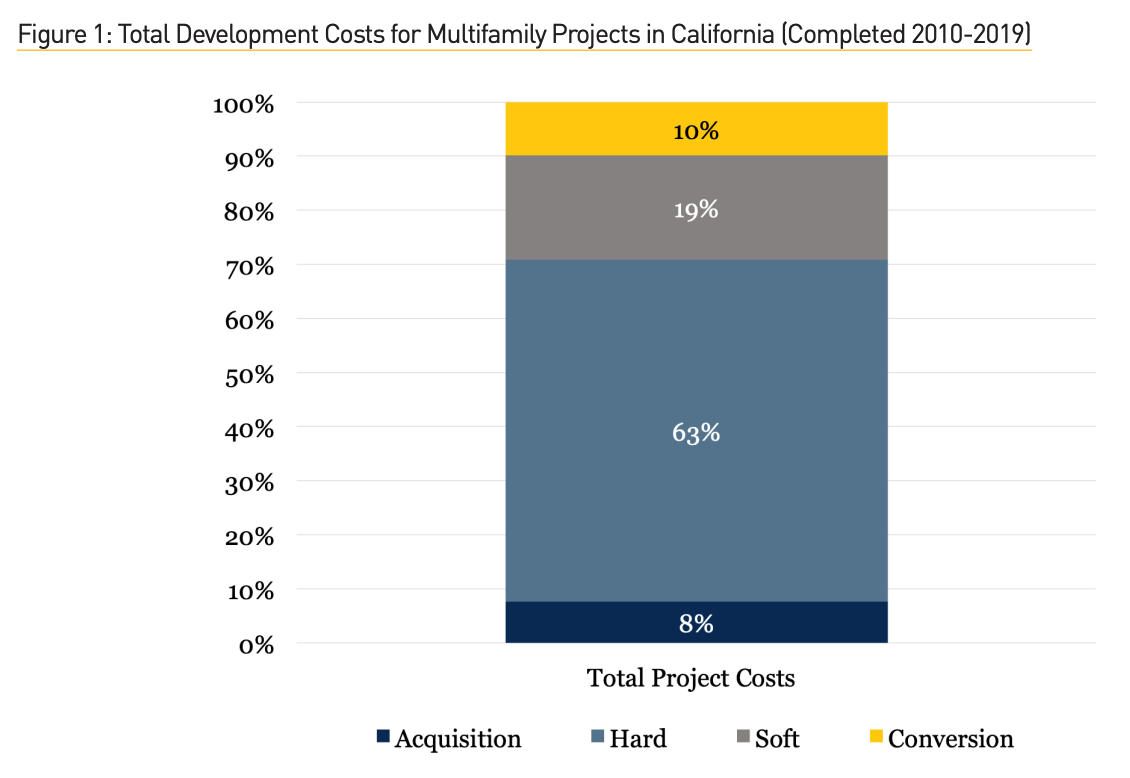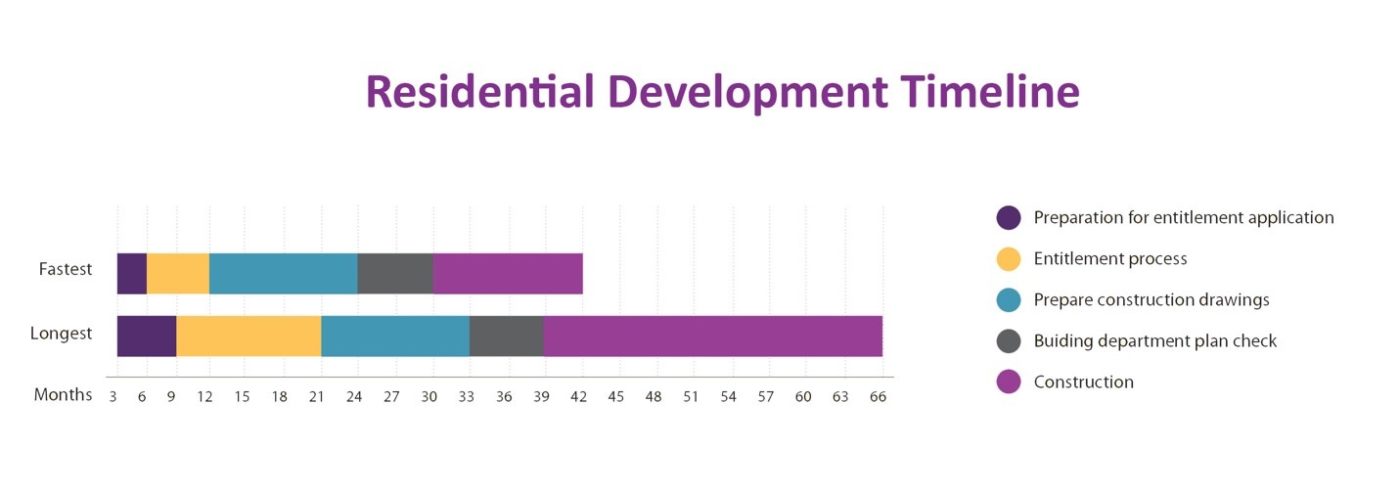Financing the development of housing is complex, and financing affordable housing development is even more complicated. It requires significant subsidy to ensure that unit sales or rents can be maintained at affordable levels.
The major components of cost for multifamily projects in California are shown in the chart below, which is not meant to represent a specific project. The cost stack is separated into:
- Acquisition (land)
- Hard Costs (materials and labor)
- Soft Costs (legal and professional fees, insurance, and development fees)
- Cost of Conversion (title fees and operating deficit reserve).
As you can see, the most significant of the cost components is materials and labor (hard construction), which accounts for more than 60% of project costs.

A financial plan or pro forma is created and analyzed to consider sensitivities and variables that can impact the feasibility of a project. A developer of ownership housing determines feasibility based on whether anticipated sales prices will cover all of these costs. A rental housing developer looks at whether rents are sufficient to meet mortgage payments plus pay for ongoing property management and maintenance. In both cases developers will build in a profit, typically 10-15% of the total cost of development.
A developer assumes significant risks when moving forward with a development project. An economic downturn after construction starts could render the projected sales prices or rents obsolete as demand for housing shrinks. With a for-sale project, a higher than expected increase in mortgage interest rates could mean that sales prices need to be lowered. The highest risk projects are high-rise condominiums.
Primary components of the cost of development
Land Costs – Land costs vary by location within Santa Clara County, and are generally higher in North and West County than in San Jose and South County. Even within San Jose, there is considerable difference in land prices, from $5.5 million per acre in the south and east parts of town and, in some cases, $18 million per acre in Downtown, an increase of more than 40% since 2016.
Hard Construction Costs – “Hard Construction Costs” include both materials and labor. The cost varies by the type of building being constructed, with steel or reinforced concrete framing required for higher-density buildings being more expensive per square foot than wood-frame construction allowed in lower-rise buildings. Buildings that have podium-style parking are more expensive than buildings with surface parking. High rises are the most expensive building type.
Labor costs are a significant cost factor. The boom in the employment sector, starting in mid-2009 following the Great Recession, has created shortages of construction labor. This coupled with material supply shortages has driven costs up more than 25% over the last decade.
Soft Costs – Developers must budget for “soft costs” in their development pro forma. In the predevelopment phase, such costs include: preparation of plans and environmental documents needed to apply for zoning permits and other discretionary land use entitlements; preparation of plans for obtaining building permits; and legal costs. During construction, such costs include: insurance; additional legal costs; marketing; and general management oversight.
Fees – Jurisdictions charge fees for reviewing entitlement and building permit processing (e.g., planning, building, utility, etc.). Fees or taxes are assessed to finance parks, streets, sewers, and other infrastructure needed to accommodate the new development. Some jurisdictions charge a Housing Impact Fee, though most have abandoned this practice in favor of inclusionary housing requirements.
Financing Costs
A development can go through multiple stages of financing. Early financing is the most expensive because it has the highest risk of the development not achieving its final goal. The closer a development is to occupancy, the lower the financial risk.
Developers typically do not take ownership of a project site until after land use entitlements are approved; in the meantime, they make “option” payments to the property owner to keep the land under contract. If the purchase is made using borrowed funds, that loan requires interest payments. All soft and hard costs are included in the construction loan, which also accrues interest. After construction and the development has mostly been rented, a permanent loan (or mortgage) pays off all previously incurred debt plus accumulated interest.
Santa Clara County found that the total cost of affordable housing can be 36% higher per unit compared to market rate housing. Several factors account for this, including additional requirements affordable housing developers seeking public funding sources must adhere to.
Housing development takes a considerable amount of time, with typical time between idea and move in of three to six years depending on the project’s complexity and other variables such as weather and environmental issues. Once the developer has secured an option to purchase the property, it takes six months or longer to draw up plans and prepare environmental studies before filing for zoning permits or other discretionary approvals. The entitlement process, where the developer receives zoning permits and other needed approvals, consumes another six to nine months for projects with community support, but can take significantly longer for projects to work through community alignment if it does not initially match what a community is willing to support. After approval, it takes another 12 months to prepare construction drawings, then another four to five months for building code compliance and review. Once construction starts, it will typically take 12 months for a low-rise building with surface parking, 18 months for a mid-rise wood-framed building on a concrete podium over parking, or 24 months for a steel- or concrete-framed high-rise building.

The cost of affordable housing can be higher than conventional market rate housing when affordable housing developer financing terms require development fees that market rate projects might not be subject to. Studies from the Terner Center for Housing Innovation and National Housing Council illustrate this key challenge housing developers must balance when setting out to create affordable housing.
Several recent State housing laws aim to remove local barriers to development and streamline housing production, such as SB 330, SB 35, SB 9, SB 10, AB 2345, AB 2162, and others. When coupled with financing and construction innovations, housing developers have found success with these tools to create homes twice as fast for 2/3rds the cost. Mercy Housing’s 833 Bryant Street Studio Project in San Francisco offers an illustrative case study.
Additional Resources
- Santa Clara County: Affordable Housing Nexus Studies
- Urban Institute: The cost of affordable housing: Does it pencil out?
- Terner Center: Making It Pencil: The Math Behind Housing Development (December 2023 Update)
- Terner Center: The Hard Costs of Construction: Recent Trends in Labor and Materials Costs for Apartment Buildings in California
- Terner Center: Construction Costs
- Terner Center: Development Fees and Taxes – General
- San José City Council Study Session: Local Development Fees and Taxes
- San José City Council Study Session: Project Feasibility
- San José City Council Staff Memo: Project Feasibility by Location
- National Housing Conference: The Cost of Affordable Housing – Does it pencil?

